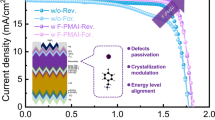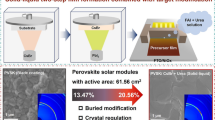Abstract
In recent years, the behavior of light and elevated temperature-induced degradation (LeTID) has seriously influence on the performance and stability of high efficiency passivated emitter and rear contact (PERC) solar cells and thus remains a crucial challenge for manufacturers. In this work, we explored the LeTID behavior of p-type boron-gallium co-doped commercial multicrystalline silicon (mc-Si) PERC cells under different firing conditions with or without hydrogenation with electron injection (HEI) treatment. It was found that kinetics of LeTID were strongly affected by the peak firing temperature, and the injection carriers could change the kinetic behavior. A fitting model was implemented to explore the influence of carrier injection on the dependence between firing conditions and LeTID behavior. This dependence relationship was explained by the variation of hydrogen concentration, which was modulated by the peak firing temperature. In addition, a trajectory equation of hydrogen and related theoretical model were established to systematically describe the mechanism that might trigger the LeTID behavior. Finally, response surface methodology (RSM) were used to explore and optimize solutions to improve performance and stability of the cells. These results were not only contribution to elucidate potential mechanism of LeTID, but also to guide the development matching commercial PERC cells.
Similar content being viewed by others

Data Availability
The data that support the findings of this study are available from the corresponding author upon reasonable request.
References
Grant NE, Scowcroft JR, Pointon AI, Al-Amin M, Altermatt PP, Murphy JD (2020). Sol Energy Mater Sol Cells 206:110299
Zhang SD, Peng JQ, Qian HQ, Shen HL, Wei QZ, Lian WF et al (2019). Energies 12:416
Modanese C, Mt W, Wolny F, Oehlke A, Laine HS, Inglese A et al (2018). Sol Energy Mater Sol Cells 186:373
Tabea L, Marko T, Christian H (2018). Sol Energy Mater Sol Cells 187:194
Derricks C, Herguth A, Hahn G, Romer O, Pernau T (2019). Sol Energy Mater Sol Cells 195:358
Lindroos J, Savin H (2016). Sol Energy Mater Sol Cells 147:115
Möller C, Lauer K (2013). Phys Status Solidi RRL 7:461
Kersten F, Engelhart P, Ploigt H-C, Stekolnikov A, Lindner T, Stenzel F et al (2015). Sol Energy Mater Sol Cells 142:83
Fertig F, Krauß K, Rein S (2014). Phys Status Solidi RRL 9:41
Nakayashiki K, Hofstetter J, Morishige AE, Li T, Needleman DB, Jensen MA et al (2016). IEEE J Photovolt 6:860
Chen D, Kim M, Stefani BV, Hallam BJ, Abbott MD, Chan CE et al (2017). Sol Energy Mater Sol Cells 172:293
Wagner M, Wolny F, Hentsche M, Krause A, Sylla L, Kropfgans F et al (2018). Sol Energy Mater Sol Cells 187:176
Sperber D, Herguth A, Hahn G (2017). Phys Status Solidi RRL 11:1600408
Sharma R, Chong AP, Li JB, Aberle AG, Huang Y (2019). Sol Energy Mater Sol Cells 195:160
Schmid A, Fischer C, Skorka D, Herguth A, Winter C, Zuschlag A et al (2021). IEEE J Photovoltaics 11:967
Vargas C, Kim K, Coletti G, Payne D, Chan C, Wenham S et al (2018). IEEE J Photovolt 8:413
Jensen MA, Zuschlag A, Wieghold S, Skorka D, Morishige AE, Hahn G et al (2018). J Appl Phys 124:085701
Chan CE, Payne DNR, Hallam BJ, Abbott MD, Wenham SR (2016). IEEE J Photovolt 6:1473
Jensen MA, Morishige AE, Hofstetter J, Needleman DB, Buonassisi T (2017). IEEE J Photovolt 7:980
Morishige AE, Jensen MA, Needleman DB, Nakayashiki K, Hofstetter J, Li T et al (2016). IEEE J Photovolt. 6:1466
Bredemeier D, Walter DC, Herlufsen S, Schmidt J (2016). Energy Procedia 92:773
Bredemeier D, Walter DC, Schmidt J (2018). Sol RRL 2:1700159
Schmidt J, Bredemeier D, Walter DC (2019). IEEE J Photovolt 9:1497
Lin DH, Hu ZC, Song LH, Yang DR, Yu XG (2021). Sol Energy 225:407
Kwapil W, Niewelt T, Schubert MC (2017). Sol Energy Mater Sol Cells 173:80
Payne DNR, Chan CE, Hallam BJ, Hoex B, Abbott MD, Wenham SR et al (2016). Sol Energy Mater Sol Cells 158:102
Payne DNR, Chan CE, Hallam BJ, Hoex B, Abbott MD, Wenham SR et al (2016). Phys Status Solidi RRL 10:237
Zhou CL, Ji FX, Cheng SZ, Zhu JJ, Wang WJ, Hu DL (2020). Sol Energy Mater Sol Cells 211:110508l
Winter M, Walter D, Bredemeier D, Schmidt J (2019). Sol Energy Mater Sol Cells 201:110060
Gläser M, Lausch D (2015). Energy Procedia 77:592
Li SM, Shao JB, Xi X, Liu GL, Peng RY, Chen RL et al (2020). Bull Mater Sci 43:1
Li SM, Xi X, Liu GL, Shao JB, Peng RY, Wang L et al (2021). J Renew Sustain Energy 13:023501
Wilking S, Engelhardt J, Ebert S, Beckh C, Herguth A, Hahn G (2014) 29th European photovoltaic solar energy conference and exhibition, Amsterdam, Netherlands 366
Lin DH, Hu ZC, He QY, Yang DR, Song LH, Yu XG (2021). Sol Energy Mater Sol Cells 226:111085
Vargas C, Nie S, Chen D, Chan C, Hallam B, Coletti G et al (2019). IEEE J Photovolt 9:335
Bredemeier D, Walter D, Herlufsen S, Schmidt J (2016). AIP Adv 6:035119
Voronkov VV, Falster R (2017). Phys Status Solidi B 254:1600779
Johnson NM, Doland C, Ponce F, Walker J, Anderson G (1991). Physica B Condensed Matter 170:3
Hamer P, Hallam B, Bonilla RS, Altermatt PP, Wilshaw P, Wenham S (2018). J Appl Phys 123:043108
Zhu J, Johnson NM, Herring C (1990). Phys Rev B 41:12354
Sun C, Rougieux FE, Macdonald D (2015). J Appl Phys 117:045702
Sheoran M, Kim DS, Rohatgi A, Dekkers HFW, Beaucarne G, Young M et al (2008). Appl Phys Lett 92:172107
Hallam BJ, Hamer PG, Wenham SR, Abbott MD, Sugianto A, Wenham AM et al (2014). IEEE J Photovolt 4:88
Walter DC, Bredemeier D, Falster R, Schmidt J, Voronkov VV (2020) 37th Eur. Photovoltaics Sol. Energy Conf. Exhib. 1:140
Hamer P, Hallam B, Wenham S, Abbott M (2014). IEEE J Photovoltaics 4:1252
Sperber D, Schwarz A, Herguth A, Hahn G (2018). Phys Status Solidi A 215:1800741
Sperber D, Schwarz A, Herguth A, Hahn G (2018). Sol Energy Mater Sol Cells 188:112
Acknowledgements
This thesis would not have been possible without the consistent and valuable reference materials that I received from my supervisor, whose insightful guidance and enthusiastic encouragement in the course of my shaping this thesis definitely gain my deepest gratitude.
Funding
This project is supported by The National Natural Science Foundation of China (grant No. 61804066), The Natural Science Foundation of Jiangsu Province (grant No. BK20180596, BK20180601), China Postdoctoral Science Foundation (2020 M671602), Jiangsu Postdoctoral Science Foundation (2020K143B), Postgraduate Research & Practice Innovation Program of Jiangsu Province (grant No. KYCX20_1770).
Author information
Authors and Affiliations
Contributions
All authors have contributed to the concept, data collection, data analysis and interpretation of the paper. Shaomin Li contributed to data processing and analysis, and write the first draft. Xi Xi was mainly responsible for organizing the concept of the article and guiding the overall content. Guilin Liu polished previous versions of manuscript. Lan Wang participated in data collection, Liping Chen participated in data collection, Yanfeng Jiang commented on the manuscript. All authors read and approved the final manuscript.
Corresponding author
Ethics declarations
Ethics Approval
The authors declare that all procedures followed were in accordance with the ethical standards.
Consent to Participate
All the authors declare their consent to participate in this research article.
Consent for Publication
All the authors declare their consent for publication of the article on acceptance.
Conflict of Interest
The authors declare that there is no conflict of interest regarding the publication of this paper.
Research Involving Human Participants and/or Animals
This article does not contain any studies with human participants or animals performed by any of the authors.
Informed Consent
Not applicable.
Additional information
Publisher’s Note
Springer Nature remains neutral with regard to jurisdictional claims in published maps and institutional affiliations.
Rights and permissions
About this article
Cite this article
Li, S., Xi, X., Liu, G. et al. Potential Mechanism of LeTID Dynamic Behavior Dependent on Firing and Hydrogenation with Electron Injection. Silicon 14, 11443–11451 (2022). https://doi.org/10.1007/s12633-022-01831-3
Received:
Accepted:
Published:
Issue Date:
DOI: https://doi.org/10.1007/s12633-022-01831-3



